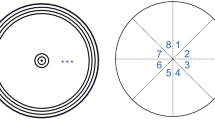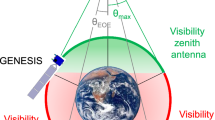Abstract
Monitoring the quality of global navigation satellite system (GNSS) signals is of primary importance for a variety of applications requiring high levels of robustness, reliability and integrity. A key element in the signal quality verification is the evaluation of the available power at the user location, including its spatial characteristics. As such, the expected performance of the GNSS satellite antenna is, for most applications, assumed as nominal. However, due to a variety of reasons such as degradation due to heavy strains during launch as well as space environment factors, it is possible that the GNSS satellite antennas exhibit non-nominal performance in the transmitted power. An analysis and evaluation of the navigation signal quality require the investigation of such cases. To this end, this study describes a methodology for the estimation and reconstruction of non-absolute GNSS satellite antenna gain patterns, focusing on satellites of the Galileo navigation system. A key feature of the presented strategy is the employed setup of reduced complexity, which includes a low-gain antenna that allows monitoring signals from several navigation satellites at the same time. The results obtained pave the way for future multi-satellite, multi-constellation analyses of transmitted signal power, which may significantly support safety-critical applications. Additionally, the presented methodology may serve as the basis for the reconstruction of absolute antenna gain patterns, which are of particular interest for GNSS reflectometry applications.









Similar content being viewed by others
References
Ajioka JS, Harry HE Jr (1970) Shaped beam antenna for earth coverage from a stabilized satellite. IEEE Trans Antennas Propag 18(3):323–327. https://doi.org/10.1109/TAP.1970.1139681
Allende-Alba G, Thoelert S, Meurer M (2018) Galileo antenna gain pattern estimation for signal quality monitoring. In: Proceedings of the 9th NAVITEC, December 5–7, Noordwijk, Netherlands
Arenas S, Monjas F, Montesano A, Montesano C, Mangenot C (2011) Performances of the Galileo system navigation antenna for global positioning. In: Proceedings of the 5th EUCAP, April 10–15, Rome, Italy
Bar-Sever YE (1996) A new model for GPS yaw attitude. J Geod 70(11):714–723. https://doi.org/10.1007/BF00867149
Brumbaugh C, Love AW, Randall G, Waineo D, Wong SH (1976) Shaped beam antenna for the global positioning system. In: Proceedings of the antennas and propagation society international symposium, Oct 11–15, Amherst
Caizzone S, Circiu MS, Elmarissi W, Enneking C, Felux M, Kazeem Y (2019) Antenna influence on global navigation satellite system pseudo range performance for future aeronautics multifrequency standardization. Navigation 66(1):99–116. https://doi.org/10.1002/navi.281
Circiu MS, Meurer M, Felux M, Gerbeth D, Thoelert S, Vergara M, Enneking C, Sgammini M, Pullen S, Antreich F (2017) Evaluation of GPS L5 and Galileo E1 and E5a performance for future multifrequency and multiconstellation GBAS. Navigation 64(1):149–163. https://doi.org/10.1002/navi.181
Czopek FM, Shollenberger S (1993) Description and performance of the GPS block I and II L-band antenna and link budget. Proceedings ION ITM 1993. Institute of Navigation, Salt Lake City, pp 37–43
Edgar C, Goldstein DB, Bentley P (2002) Current constellation GPS satellite ground received signal power measurements. Proceedings ION NTM 2002. Institute of Navigation, San Diego, pp 948–954
Fuchs B, Le Coq L, Rondineau S, Migliore MD (2017) Fast antenna far-flied characterization via sparse spherical harmonic expansion. IEEE Trans Antennas Propag 65(10):5503–5510. https://doi.org/ 10.1109/TAP.2017.2738059
Gatti G, Falcone M, Alpe V, Malik M, Burger T, Rapisarda M, Rooney E (2008) GIOVE-B Chibolton in-orbit test—initial results from the second Galileo satellite. Inside GNSS, September/October, pp 30–35
Hartman T, Boyd LR, Koster D, Rajan JA, Harvey J (2000) Modernizing the GPS block IIR spacecraft. In: Proceedings ION ITM 2000. Institute of Navigation, Salt Lake City, pp 2115–2121
Joseph A (2010) Measuring GNSS signal strength. Inside GNSS, November/December, pp 20–25
Marquis WA (2016) The GPS IIR antenna panel pattern and its use on-orbit. In: Proceedings ION ITM 2016. Institute of Navigation, Portland, pp 2896–2909
Marquis WA, Reigh DL (2015) The GPS block IIR and IIR-M broadcast L-band antenna panel: its pattern and performance. Navigation 62(4):329–347. https://doi.org/10.1002/navi.123
Montenbruck O et al (2014) The multi-GNSS experiment (MGEX) of the international GNSS service (IGS)—achievements, prospects and challenges. Adv Space Res 59(7):1671–1697. https://doi.org/10.1016/j.asr.2017.01.011
Montenbruck O, Schmid R, Mercier F, Steigenberger P, Noll C, Fatkulin R, Kogure S, Ganeshan AS (2015) GNSS satellite geometry and attitude models. Adv Space Res 56(6):1015–1029. https://doi.org/10.1016/j.asr.2015.06.019
Montesano A, Montesano C, Caballero R, Naranjo F, Monjas F, Cuesta, LE, Zorrilla P, Martinez L (2007) Galileo system navigation antenna for global positioning. In: Proceedings of the 2nd EUCAP, November 11–16, Edinburgh
Ruf C, Lyons A, Unwin M, Dickinson J, Rose R, Rose D, Vincent M, Lyons A (2013) CYGNSS: enabling the future of Hurricane prediction. IEEE Geosci Remote Sens Mag 1(2):52–67. https://doi.org/10.1109/MGRS.2013.2260911
Steigenberger P, Thoelert S, Montenbruck O (2018) GNSS satellite transmit power and impact on orbit determination. J Geod 92(6):609–624. https://doi.org/10.1007/s00190-017-1082-2
Thoelert S, Erker S, Meurer M (2009) GNSS signal verification with a high gain antenna—calibration strategies and high quality signal assessment. In: Proceedings ION ITM 2009. Anaheim, Institute of Navigation, pp 289–300
Thoelert S, Meurer M, Erker S (2012) In-orbit analysis of antenna pattern anomalies of GNSS satellites. Navigation 59(2):135–144. https://doi.org/10.1002/navi.11
Valle P, Netti A, Zolesi M, Mizzoni R, Bandinelli M, Guidi R (2006) Efficient dual-band planar array suitable to GALILEO. In: Proceedings of the 1st European conference on antennas and propagation. IEEE, Nice, France, 6–10 November 2006
Wang T, Ruf CS, Block B, McKague DS, Gleason S (2019) Design and performance of a GPS constellation power monitor system for improved CYGNSS L1B calibration. IEEE J Sel Top Appl Earth Obs Remote Sens 12(1):26–36. https://doi.org/10.1109/JSTARS.2018.2867773
Won JH, Pany T (2017) Signal processing. In: Teunissen PJG, Montenbruck O (eds) Global navigation satellite systems handbook. Springer, Berlin, pp 401–442
Acknowledgements
This study makes use of broadcast ephemeris products from the Multi-GNSS Experiment of the International GNSS Service. The support of all the involved institutions and analysis centers is gratefully acknowledged. The authors are thankful to Stefano Caizzone for providing data and support on the employed receive antenna.
Author information
Authors and Affiliations
Corresponding author
Additional information
Publisher's Note
Springer Nature remains neutral with regard to jurisdictional claims in published maps and institutional affiliations.
Rights and permissions
About this article
Cite this article
Allende-Alba, G., Thoelert, S. Reconstructing antenna gain patterns of Galileo satellites for signal power monitoring. GPS Solut 24, 22 (2020). https://doi.org/10.1007/s10291-019-0937-9
Received:
Accepted:
Published:
DOI: https://doi.org/10.1007/s10291-019-0937-9




